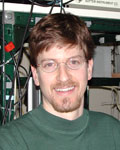
Steven M. Block
Stanford W. Ascherman, M.D. Professorof Applied Physics and of Biology
Research areas:
Biophysics, Nano Sci/Eng, Precision Measurement
Description
Biophysics
The Block lab, which carries out research in the area of single molecule biophysics, explores the nanoscience of life. Nature’s own nanoscale machines, which include proteins and nucleic acids, are complex macromolecules that are exquisitely ‘designed’ (evolutionarily adapted!) to carry out a multitude of sophisticated functions. Using modern laser-based approaches, which include optical traps, single-molecule fluorescence/FRET, and advanced microscopies, we’ve been able to develop instruments that can measure the nanometer-scale displacements and piconewton-scale forces associated with individual biomolecules. Among the things we’re studying these days are kinesin (a motor protein), RNA polymerase (the enzyme that reads the genetic code), riboswitches (mRNA molecules that fold into shapes and regulate genes), and more (ribozymes, transcription accessory factors, such as NusA/G, Gre A/B, TFIIS/TFIIF, rho, etc.)
Nanoscience and Quantum Engineering
The Block lab, which carries out research in the area of single molecule biophysics, explores the nanoscience of life. Nature’s own nanoscale machines, which include proteins and nucleic acids, are complex macromolecules that are exquisitely ‘designed’ (evolutionarily adapted!) to carry out a multitude of sophisticated functions. Using modern laser-based approaches, which include optical traps, single-molecule fluorescence/FRET, and advanced microscopies, we’ve been able to develop instruments that can measure the nanometer-scale displacements and piconewton-scale forces associated with individual biomolecules. Among the things we’re studying these days are kinesin (a motor protein), RNA polymerase (the enzyme that reads the genetic code), riboswitches (mRNA molecules that fold into shapes and regulate genes), and more. Our work also involves, among many other things, the nanofabrication of chemically-derivatized quartz cylinders and other shapes for optical trapping and the attachment of biomolecules, and the development of cutting-edge micro- and nanofluidic devices for use in biological assays.
Lasers and Accelerators
The Block lab, which carries out research in the area of single molecule biophysics, explores the nanoscience of life. Nature’s own nanoscale machines, which include proteins and nucleic acids, are complex macromolecules that are exquisitely ‘designed’ (evolutionarily adapted!) to carry out a multitude of sophisticated functions. Using modern laser-based approaches, which include optical traps, single-molecule fluorescence/FRET, and advanced microscopies, we’ve been able to develop instruments that can measure the nanometer-scale displacements and piconewton-scale forces associated with individual biomolecules. Among the things we’re studying these days are kinesin (a motor protein), RNA polymerase (the enzyme that reads the genetic code), riboswitches (mRNA molecules that fold into shapes and regulate genes), and more. We use microscopes, optics and highly stabilized DPSS lasers extensively in our work.
Condensed Matter Physics
The Block lab, which carries out research in the area of single molecule biophysics, explores the nanoscience of life. Nature’s own nanoscale machines, which include proteins and nucleic acids, are complex macromolecules that are exquisitely ‘designed’ (evolutionarily adapted!) to carry out a multitude of sophisticated functions. Using modern laser-based approaches, which include optical traps, single-molecule fluorescence/FRET, and advanced microscopies, we’ve been able to develop instruments that can measure the nanometer-scale displacements and piconewton-scale forces associated with individual biomolecules. Among the things we’re studying these days are kinesin (a motor protein), RNA polymerase (the enzyme that reads the genetic code), riboswitches (mRNA molecules that fold into shapes and regulate genes), and more. We have recently been able to achieve angstrom-level sensitivity with our instruments, and can consequently record the individual base-pair steps taken by polymerase molecules that move along DNA: these measure just 3.4 angstroms each.
Courses Taught
Selected Publications
- Direct observation of hierarchical folding in single riboswitch aptamers
- Direct observation of the binding state of the kinesin head to the microtubule
- Applied force reveals mechanistic and energetic details of transcription termination
- Nanomechanical measurements of the sequence-dependent folding landscapes of single nucleic acid hairpins
- Single-molecule, motion-based DNA sequencing using RNA polymerase
- Sequence-resolved detection of pausing by single RNA polymerase molecules
- Passive all-optical force clamp for high-resolution laser trapping
- Statistical kinetics of macromolecular dynamics
- Direct observation of base-pair stepping by RNA polymerase
- Kinesin moves by an asymmetric hand-over-hand mechanism
- Force and velocity measured for single molecules of RNA polymerase
- Direct observation of kinesin stepping by optical trapping interferometry
 Sebastian Doniach
Sebastian Doniach
 Daniel S. Fisher
Daniel S. Fisher
 Stephen Quake
Stephen Quake
 Mark J. Schnitzer
Mark J. Schnitzer
 W. E. Moerner
W. E. Moerner
 Surya Ganguli
Surya Ganguli